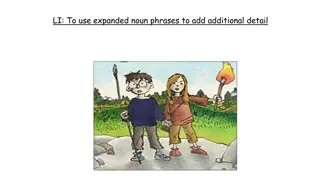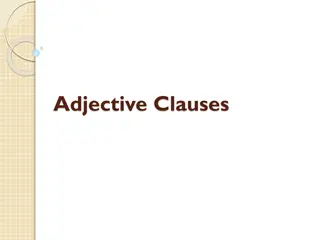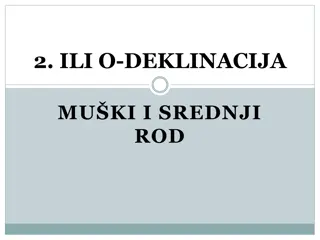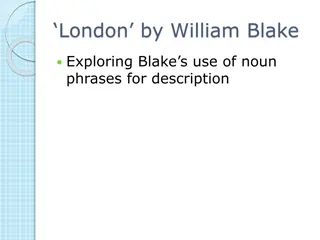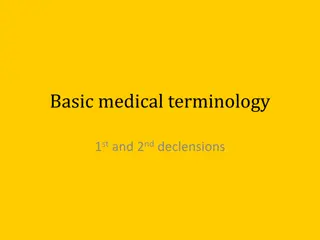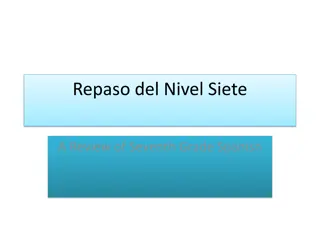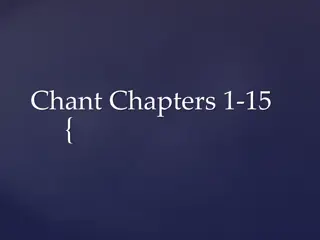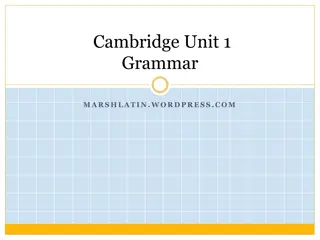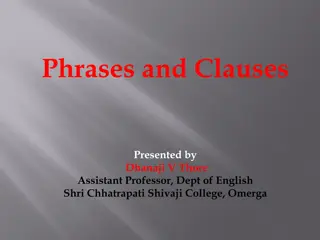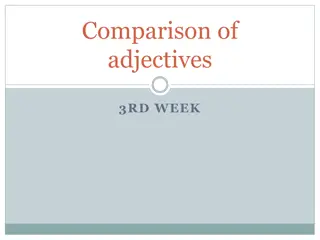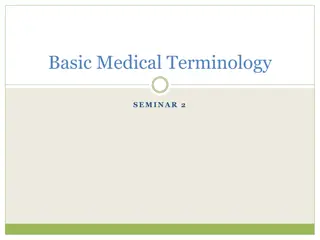Latin Noun Declensions and Adjective Agreement Study Guide
Explore the intricacies of Latin 3rd declension nouns, genitive endings, and adjective agreement with this comprehensive study guide. Learn to differentiate between paradigms, identify stem variations, and make declension decisions based on gender and form. Practice forming genitives, plurals, and phrases with prepositions for enhanced understanding.
Uploaded on Sep 23, 2024 | 1 Views
Download Presentation

Please find below an Image/Link to download the presentation.
The content on the website is provided AS IS for your information and personal use only. It may not be sold, licensed, or shared on other websites without obtaining consent from the author.If you encounter any issues during the download, it is possible that the publisher has removed the file from their server.
You are allowed to download the files provided on this website for personal or commercial use, subject to the condition that they are used lawfully. All files are the property of their respective owners.
The content on the website is provided AS IS for your information and personal use only. It may not be sold, licensed, or shared on other websites without obtaining consent from the author.
E N D
Presentation Transcript
Revision What is the genitive ending of 3rd declension nouns? -is What are the example words of the 3rd declension? dolor, corpus, pelvis, rete, dosis What is the difference between paradigm dolor and pelvis? genitive plural: dolor-um / pelv-ium What is the difference between paradigm corpus and rete? ablative singular: corpor-e / ret-i nominative and accusative plural: corpor-a / ret-ia genitive plural: corpor um / ret-ium
The difference between consonant stems and i-stems
Revision How do we decide, whether the noun is declined according to pelvis? it is of masculine / feminine gender AND it has the same number of syllables in the nominative and genitive of singular (e.g. auris, auris, f. ) OR its genitive stem ends in 2 consonants (e.g. dens, dentis, m. ) 1. 2. a) b) How do we decide, whether the noun is declined according to rete? it is of neuter gender and in nomitative singular it ends in -e, -al, -ar (animal, alis, n., calcar, aris, n., cochlear, aris, n. ) 1. 2.
Revision How do we decide, whether the noun is declined according to dosis? the nominativa singular ends in -sis, -xis, -osis the genitive is the same the dictionary entry has the genitive ending is / eos What Latin nous are declined according to dosis? febris, is, f. tussis, is, f. sitis, is, f. pertussis, is, f. tuberculosis, is, f.
Revision Give the genitive, genitive stem, declension and paradigm of following words: frons ren nervus icterus caput febris chole ascites ulcus pars labium morbus vena paries carcinoma mors narcosis ramus oculus colon nephros calcar
Add the correct adjective and form the plural Join the phrases with prepositions auris (medius, a, um) psychosis (organicus, a, um) canalis (nutricius, a, um) dens (incisivus, a, um) febris (acutus, a, um) sepsis (lentus, a, um) metastasis (isolatus, a, um) mors (clinicus, a, um) rete (venosus, a, um) In (abl.) Ante Sub (abl.) In (acc.) Propter Post Ex Post In (acc.) Aure media Psychosim organicam Canale nutricio Dentem incisivum Febrim acutam Sepsim lentam Metastasi isolata Mortem clinicam Rete venosum
Match the nouns with the appropriate adjectives 1) foramen 2) mors 3) medulla 4) injectio 5) ulcus 6) mater 7) lobus 8) febris 9) tumor 10) symphisis 11) femur 12) prognosis 13) diameter 1f, 2d, 3h, 4g, 5a, 6l, 7k, 8c, 9m, 10i, 11b, 12j, 13e a) perforatus, a, um b) fractus, a, um c) continuus, a, um d) clinicus, a, um e) obliquus, a, um f) nutricius, a, um g) subcutaneus, a, um h) flavus, a, um i) pubicus, a, um j) bonus, a, um k) sinister, tra, trum l) durus, a, um m) benignus, a, um
Fill in the missing suffixes partes hypophys_ symptomata tuberculos_ resectio radic_ dent_ sub calcar_ avi_ (position) amputatio ped_ dextr_ cum narcos_ febris cum tuss_ aether pro anaesthes_ fractura pelv_ cum haemorrhagi_ in cavitat_ abdmin_ cochlear plen_ mell_ contra tuss_ chronic_
Fill in the missing suffixes partes hypophysis symptomata tuberculosis resectio radicis dentis sub calcari avis (position) amputatio pedis dextri cum narcosi febris cum tussi aether pro anaesthesia fractura pelvis cum haemorrhagia in cavitate abdminis cochlear plenum mellis contra tussim chronicam
Join the terms to form the expressions rete + canalis + nervus + hypoglossus, a, um stratum + corneus, a, um + ungues pars + thoracicus, a, um + systema + autonomicus, a, um stenosis + ostium + venosus, a, um + sinister, tra, trum
Translate internal ear symptoms of tuberculosis lobes and parts of the hypophysis network of carpus in acute fever canine teeth venous network of the eyeball symptoms of organic psychosis antibiotics against the whooping cough symptoms of synarthrosis auris interna symptomata tuberculosis lobi et partes hypophysis rete carpi in febri acuta dentes canini rete venosum bulbi symptomata psychosis /eos organicae antibiotica contra pertussim symptomata synarthrosis / eos
Form phrases with different types of injuries Vulnus + sclopetarius, a, um + dorsum Vulnus sclopetarium dorsi 1. Sutura + vulnus + lacer, a, um + caput Sutura vulneris laceri capitis 2. Oedema + propter + vulnus + contusus, a, um + femur Oedema propter vulnus contusum femoris 3. Infectio + in + vulnus + scissus, a, um + digitus + II Infectio in vulnere scisso digiti secundi 4. Vulnus (pl.) + sectus, a, um + antebrachium Vulnera secta antebrachii 5. Sepsis + post + vulnus (pl.) + morsus, a, um + caput Sepsis post vulnera morsa capitis 6. Corpus (pl.) + alienus, a, um + in + vulnus (pl.) + punctus, a, um + abdomen Corpora aliena in vulneribus punctis abdominis 7.
A C F D G B E
Decide what is correct Patient 1 has shot wound in his left lower leg Patient 2 tore her upper lip Patient 2 suffered brain concussion Patient 3 has open fracture of his left forearm with contusion and tear wound on the lower leg Patient 4 broke her heel bone Patient 4 had simple fracture of the third thoracic vertebra Patient 4 has cut wound in the region of the left elbow bone
Name the action performed by the given muscle Musculus abductor pollicis longus >> abductio, onis, f. Adductio, onis, f. Compressio, onis, f. Constrictio, onis, f. Depressio, onis, f. Dilatatio, onis, f. Extensio, onis, f. Flexio, onis, f. Levatio, onis, f. Rotatio, onis, f. Tensio, onis, f. Musculus adductor hallucis longus Musculus compressor urethrae Musculus constrictor pharyngis medius Musculus depressor anguli oris Musculus dilatator pupillae Musculus extensor carpi Musculus flexor digitorum profundus Musculus levator glandulae thyr(e)oideae Musculi rotatores thoracis Musculus tensor fasciae latae
The muscle(s) that moves the little finger away from other fingers is helps the face to form a smile because it elevates the angles of the mouth at each corner is stretches the wide band that encloses the thigh muscles is
Translate /TASK 6a HANDOUT 6-7 function of the digestive organs functio organorum digestoriorum thorn wounds in the trunk of the body vulnera lacera in trunco corporis foreign body in the oral cavity corpus alienum in cavitate oris function of the salivary glands functio glandularum salivariarum serous tunic of the gullet tunica serosa oesophagi walls of the stomach parietes stomachi the body of the stomach corpus stomachi ulcers in the body of the stomach ulcera in corpore stomachi / ventriculi (organS -> plural) (woundS->plural; in (position) +abl.) (in (position) +abl.) (glandS -> plural) (don`t confuse pars, partis, f. with paries, etis, m.) (ulcerS->plural, ulcus is neuter-> ulcera)
Translate /TASK 6a HANDOUT 6-7 perforated intestines intestina perforata sugical therapy of perforated intestines therapia chirurgica intestinorum perforatorum symptoms of the intestine perforation symptomata perforationis intestini adjecive meaning intestine -> perforation of the intestine) cancer of the sigmoid colon cancer coli sigmoidei right and left lobe of the liver lobus hepatis dexter et sinister tumor of the head of the pancreas tumor capitis pancreatis body and neck of pancreas corpus et cervix pancreatis (intestineS->plural, intestinum is neuter-> intestina) (intestineS->plural) (perforation is a noun; there is no
Find opposites/TASK 8 UNIT 4 pia benignus sinister rubra acquisitum magna secundam interna mala acuta Dura mater encephali Tumor malignus Pes dexter Medulla ossium flava Vitium congenitum Regio parva Sanatio per primam intentionem Auris externa Prognosis bona Nephrosis chronica


